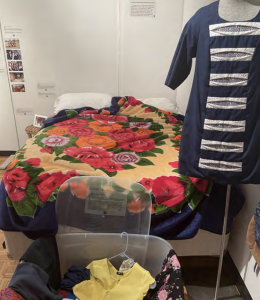Annex Gallery art explores trauma of Hmong families
April 21, 2021
The Annex Gallery opened up the exhibit “The Battlefields of Memory” on April 5, which explores hope through artifacts, objects and the stories of Hmong people’s experience of war and traveling to America.

“The Battlefields of Memory” exhibit, whose theme is ‘home as a medium,’ shows how memories have shaped Hmong lives.
The gallery was a partnership between Hmong students, the Wisconsin Historical society, Hmong studies professor Mai See Thao and non-profit organization, Cia Siab, Inc.
Thao and the Cia Siab team both said that the Hmong students involved gave their perspectives and that was crucial to the exhibit.
UWO student Liseng Xiong said that he became a part of the team at Cia Siab because of taking Thao’s class.
Liseng has an internship with the organization and worked with them on the exhibit.
Liseng said that for him, the exhibit’s meaning is to show the human struggle that the Hmong people faced when they came to the United States.
“I think that it is very important, especially right now during this pandemic and resurgence of Asian hate in the limelight,” he said. “It shows that we are not an exotic group here for no reason, but a people here looking to find refuge from violence and war.”
Amy Xiong, another student that worked on the exhibit, said that the exhibit is more than just showcasing the Hmong people and culture, but it helps to capture the aftermath of genocide and war.
“It shows how these invisible experiences of historical trauma have shadowed the HMoob community into their acculturation to the US,” she said. “Even though war trauma has impacted the community immensely, the HMoob’s continues to stay resilient despite simultaneously dealing with racial injustices, whether it is on a macro or micro level, and socio-economic challenges.”
Amy said that the exhibit theme “home as a medium” shows the intimate relationships between our memories and how they shaped our lives.
“It shows the trauma that refugee people face, not having a home to return to so we had to make one for ourselves,” she said.
Amy said that her perspective of “home as a medium” is that it explores how the trauma and struggles of Hmong families are often kept silent.
“Our deepest fears are kept and confined to our bedrooms, as it is our private place, the place to sleep and recollect our experiences,” she said. “This is why objects, such as objects within the bedroom, hold such strong meanings, as each of them have their own story to tell.”
Amy said that what he hopes that people see from the exhibit that we are human and part of this country as much as anyone else
“I feel that not much is really that known about the Hmoob community by the majority of people, and what they do know is that we were a part of an American War, the Secret War,” he said. “This exhibit is to show that we are more than that, that we are people who have made an impact as citizens of the United States.”
Amy said she hopes that people can really embody the experiences and stories showcased in the exhibit.
“War is not just something physical that happens overseas and off our shores, but within our memories, private lives and in our own bedrooms,” she said.
To see the work that both Amy and Liseng Xiong did with the exhibit, check out “The Battlefields of Memory” on the second floor of the Arts and Communication building.













